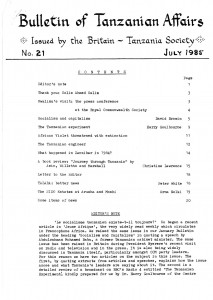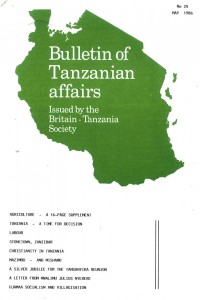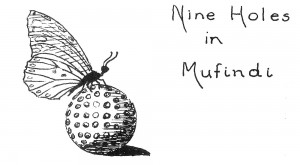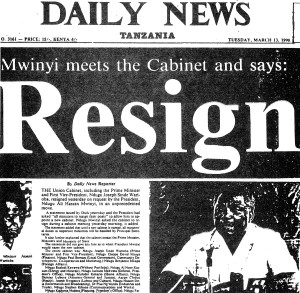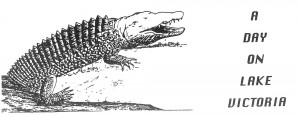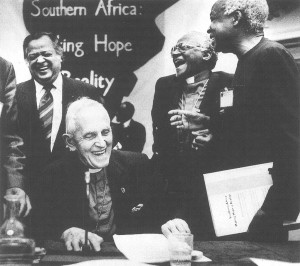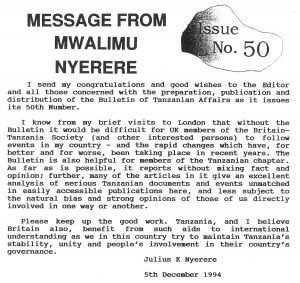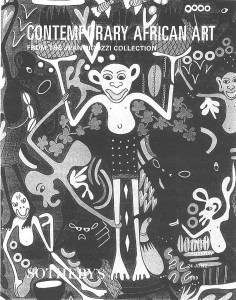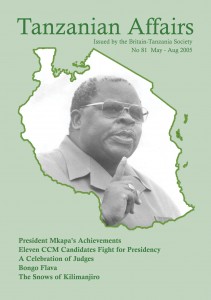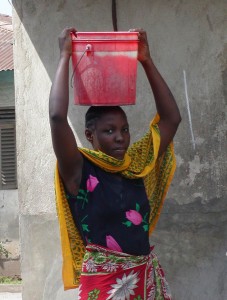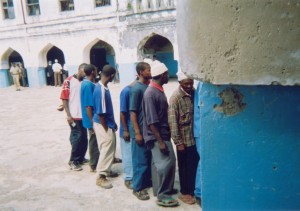The following appeared in TA Issue 100, and contains brief notes on some of the more unusual and memorable stories to have featured in Tanzanian Affairs over the years, with apologies for the large number of articles which have been missed, and the inevitable personal bias in the selection. Please write in or comment online about any other articles that you particularly remember.
Jacob Knight
Issue 1 (Dec 1975) edited by Dr Terence Ranger is in A4 format with 12 pages, and brings news of the first passenger train leaving Kapiri Mposhi station in Zambia for Tanzania – the TAN-ZAM (TAZARA) railway is born. TANU have published a booklet claiming that over 9 million people have been resettled in villages, but the Bulletin suggests that not everyone is happy, with widespread reports of resistance to villagisation.
Issue 4 (January 1977) announces the formation of the ‘Chama Cha Mapinduzi’ (Society of the Revolution) combining the two ruling parties – the Tanganyika African National Union (TANU) and the Zanzibar Afro-Shirazi Party.
The release from detention of Mr Abdulrahman Mohamed Babu and three others who had been condemned to death in Zanzibar, in absentia, for their alleged part in the assassination of the first President of Zanzibar, Sheikh Karume, is covered in Issue 6.
Issue 7 contains even more dramatic news – the Idi Amin regime in Uganda has invaded Tanzania in October 1978 and Tanzania is mobilising for war. The Bulletin has a new editor, Mr John Arnold, and it has grown to 18 pages.
Issue 11 in December 1980 is a special issue devoted to the state of the Economy. Tanzania’s long period of negotiation with the IMF is under way.
Issue 15 covers the story of the hijacking of a Tanzanian aircraft and the subsequent arrest of the hijackers in Britain. A tragic sequel to this event is the death of Musa Membar after being held in administrative detention on his return to Tanzania (Issue 40).
Issue 19, now under the present editor, David Brewin, records the untimely death of Tanzania’s popular Prime Minister, Mr Edward Sokoine.
President Nyerere’s visit to the UK is covered in Issue 21 (July 1985), where in a “short but tough” interviewon BBC Newsnight with Peter Snow he was asked: “Is there not some way in which the system, particularly the agricultural system, the communal socialism which you introduced in Tanzania… has caused the failure of your country to produce what it should be producing?” The President replied: “What do you say to that ? African agriculture is backward in socialist and non-socialist countries alike. In my country we use the hand hoe. In capitalist countries in Africa they use the hand hoe. That defines the limits of what the peasant can do. The difference between a socialist country like Tanzania and a non-socialist country is that the burdens of poverty are shared better in a socialist country than they are in a non-socialist country.”
Issue 22 (Oct 1985) marks the change to the A5 booklet edition which we are all familiar with (cover designed by Richard Moon). It includes a special supplement “The Nyerere Years” to mark the end of his Presidency, containing essays on Nyerere from his friends including many members of the Britain-Tanzania Society – well worth a read.
Issue 24 gives weight to the economic problems facing the new President Mwinyi, but also highlights agriculture, with articles about peasant farming, the problems with transportation, and traditional knowledge on microclimate modifications (such as wind protection by scattered obstacles and trees/bushes). Randal Sadleir reviews a BBC documentary on the groundnut scheme – forty years on.
Issue 25 (1986) includes an item from the Daily Telegraph about the fate of a team of donkeys which had been used by a team of British explorers retracing the steps of Victorian explorer Stanley. After discussions involving Prince Philip, Prime Minister Mrs Thatcher, the RSPCA, and others, the Tanzanian Air Force is able to rescue them and fly them from the shores of Lake Tanganyika to Kenya where donors had provided funds to accommodate them in an animal retirement home near Nairobi. The issue also includes the first mention of the AIDS epidemic in Tanzanian Affairs noting that 125 cases of “Ukimwi” (the new Swahili word) have been reported with research workers estimating that 0.01% of inhabitants of Kagera are potential carriers.
As well as analysis of the economic recovery by Roger Carter, Issue 26 (1987) notes the sad accident during the visit of Mother Teresa to Hombolo, and covers the Kilombero sugar estate where three people were killed and many more injured by Field Force Units, called in after workers demonstrated over non-payment of overtime earnings. There is also a useful guide to the Parliament of the United Republic of Tanzania written by the speaker of the National Assembly, Chief Adam Sapi Mkwawa.
Reporting on an international conference under the heading ‘The Arusha Declaration 20 year after its Publication’ Professor Terence Ranger writes about the cheerful Christmas bustle of Arusha where for the first time in a while there are abundant goods in the shops. Many conference delegates felt that the crisis in agriculture arose because the Declaration was not effectively carried through; others felt that the Declaration was a flawed document; but everyone could agree that many of the problems stemmed from weak and corrupt party management.
An article on “Informatics Technology” in Issue 27 estimates there are currently 400 computers in Tanzania. There is also an article about Tanzanian Adam Salim and Kenyan Fadhili Williams who both claim to be the author of the legendary song “Malaika”. “A Queen’s Scarf” by Mr J.T.Purvis recalls how puzzlement over a grave inscription on a grave in Old Shinyanga led him to find out more about the “QS” decoration awarded to Major A.H Du Frayer QS OBE. Four scarves were knitted by Queen Victoria shortly before her death and awarded to soldiers who had joined the forces as rankers and had first been recommended for the Victoria Cross for an outstanding act of bravery.
In depth analysis of the difficult on-going negotiations with the IMF by Reginald Herbold Green and Roger Carter features in Issue 28. Godwin Kaduma writes about Makonde carvings and their role in ritual, sadly a meaning lost in the many mass produced carvings. A brand new Uniflote ferry, purchased for the Kigamboni crossing, has broken down after a month’s use – the Sunday New’s columnist Adam Lusekelo suspects corruption, as do many others, and invents a history of the two Tanzanians given the task of buying the ferry “… we must remind you that this matter is of the utmost importance” “Yes, I know how important this ferry is to you but…” “Who’s talking about the ferry? We are talking about our cut”…
Mwalimu Nyerere’s decision to stand for re-election as CCM chairman is discussed in Issue 29, after many had expected him to retire. The Minister of Finance Cleopa Msuya estimates Tanzania’s population as 23 million, almost double that of 1967. The problem of stowaways from Tanzania is attracting attention, with an estimated 1,000 Tanzanian youths leaving the country illegally in search of jobs. Mwalimu Nyerere criticises parents who think their children will easily acquire wealth in foreign countries.
Articles by John Budge, Caroline Hanks and Robert Whitcombe look at the problems caused by the Larger Grain Borer Beetle which has been decimating stored food crops mainly maize and cassava. Packaging insecticide in sachets suitable for treating six debbes of maize and printed with instructions in Swahili has proved very successful when combined with an extensive education campaign.
Issue 30 contains news of dramatic events in Zanzibar. In the run up to the 1985 presidential elections, Idris Wakil had narrowly beaten Seif Shariff Hamad to get the CCM candidacy. Following the election, President Wakil appointed Seif Shariff as the Chief Minister in an effort to ensure unity. However, it has ended badly with Seif Shariff Hamad suspended, thrown out of the CCM party and later arrested amid accusations of attempts to destabilise the Union (Issue 31, 33 and 34). An article by Michael Hodd entitled “From Nyerere to Neo-Classicism” about some of the reforms initiated by President Mwinyi generates a vigorous debate in the letter pages of next issues.
Issue 31 covers President Mwinyi’s visit to London and meetings with the Queen and Prime Minister Thatcher. Charles Amour’s well informed piece on the history of radio broadcasting in Tanzania answers the question “Why no Television?” (Tanzania still being without any mainland TV broadcasters). A letter from Roy Galbraith in response to a request from a reader, confirms the current price for maize (when available) is 20 TShs a kilo, with government price controls still in operation on staple foods (exchange rate £1=175 TShs).
Issue 32 (Jan 1989) carries news of Tanzania’s devaluation of its currency. An article from SHIHATA reviews a drama presented at the Moshi International School on the anniversary of the first ascent of Kilimanjaro in 1889, with dialogue in English, Kiswahili and Kimachame. Extracts from a paper by Col. F.S. Swai give a history of the metamorphosis of the King’s African Rifles into the Tanzania People’s Defence Force following the mutiny in 1964, noting how the army was politicized and made up of soldiers who identified with the ruling party TANU.
An article by editor David Brewin about his experiences on a visit to China is particularly interesting given the increasingly large role that the country is now playing in Africa. David’s several requests to interview someone who had worked on the TANZAM railway construction are met positively, but the bureaucratic machine swings slowly into action and all interviews are eventually declined. China’s residents are facing some of the same problems as Tanzania (high inflation and weak currency, Economic Reform and Structural Adjustment), but it is already clear that rapid progress is being made.
Christine Lawrence’s review of “The Snakeman” by Margaret Lane gives a brief view of the life of C.J.P Ionides, a singular character living in Newala on an escarpment overlooking Mozambique. He has “escaped from the tyranny of possessions” and survives comfortably by running a snake-catching business.
Issue 33 includes analysis by Suleman Sumra of the Education for Self-Reliance programme based on a case study village in Handeni. The conclusion is that it did not lead to fundamental transformation of the education system, partly because of dependency on external teaching materials but also because the village leadership was authoritative and hierarchical, limiting the participation of youth. Anna Pincus describes the successful tour of the four person Mellstock Band playing folk music, unaccompanied carols and a Dorset broom dance.
Issue 34 (1989) describes how President Mwinyi took the lead in proposing the world ban on ivory trade. T.C.E. Congdon’s “Nine Holes in Mufindi” gives a fascinating impression of the botany and wildlife of this beautiful golf course. The “Fifty Years Ago” section covers the internment of Germans in Tanganyika in 1939 and the first effects of war. Shirin Spencer reviews a programme on Channel 4 about the “Lightning Bird” or hammerhead (related to the heron and stork) which has legendary powers over rain and floods. Some 400,000 people are now estimated infected with HIV, with 12% adult infection levels in Kagera, and as high as 32% in Bukoba town. There are already concerns on how Tanzania will be able to cope with the number of orphans.
Issue 35 contains an article by Mark Horton on “Digging up Zanzibar” – a survey of Zanzibar’s archaeological sites and monuments. A related article in issue 37 by Alex Vines lists the threats to Tanzania’s monuments, including simple neglect but also theft of sites for building materials.
Issue 36 carries the dramatic news of President Mwinyi’s three minute cabinet meeting, where he asks all ministers to resign. The reason was corruption, and the President’s desire to wipe the slate clean with a new cabinet (although several members were re-elected). Among the new ministers is Jakaya Kikwete (Energy, Minerals & Water). John Malecela is Tanzania’s new High Commissioner in London, where he has an immediate and positive impact building cordial relations with Prime Minister John Major, elected shortly after (Issue 37). However, he is soon transferred back to Tanzania to become Prime Minister (Issue 38). Nelson Mandela and his wife Winnie visit in March 1990, and are entertained by Mwalimu Nyerere and President Mwinyi, addressing large crowds at the football stadium and also visiting Zanzibar to see the grave of former president Abeid Karume.
Issue 37 (Sept 1990) includes analysis of the 1988 census results by Clive Sowden – Dar-es-Salaam has 1.2 million inhabitants, with Mwanza the second city far behind at 183,000.
Issue 38 carries the election results, with President Mwinyi re-elected with 95.5% of votes and Dr Salmin Amour elected in Zanzibar although there one third of the electorate did not turn up to the polling stations. David Brewin writes about DANTAN (the Denmark Tanzania Association), comparing with the Britain-Tanzania Society, and suggesting how each can learn from the other.
Issue 39 (May 1991) is dominated by accounts of Minister for Home Affairs Augustine Mrema’s successful and popular attempts to reduce corruption. It also covers the “great debate” on multi-partyism. “My Father, and the useful plants of Zanzibar” by R.O.Williams Junior follows his father’s career as Director of Agriculture in Zanzibar, a job which left him with plenty of spare time in which he collected and catalogued the plants of the Isles.
“My First and Second Impressions of Tanzania” by John Drew in Issue 40 contains interesting comparisons between Tanzania and Kenya, and background on the work of Tear Fund in Iringa. There is also a forerunner of this article “We have reached number 40 after 16 years” giving a history of the publication and ending with a prophetic statement by the editor “Maybe it will eventually reach No 100. Who knows?”
The University of Dar-es-Salaam continues to face protests as it opens after a 6 month break, this time over the removal of popular Vice-Chancellor Prof. Mmari. An article in Issue 41 entitled “Three Decades at the University” Paul A Isbell paints a turbulent picture, linking the ideological struggles with the fall of the Berlin Wall and the collapse of socialism in the Soviet Union.
Issue 42 (May 1992) brings the dramatic news of “Mageuzi” with the historic declaration of Multi Party Politics. While the majority of Tanzanians (80% according to the Presidential Commission) wanted to continue with the single party CCM system, Nyerere supported the change as did most other leaders. An article on “The BBC and Tanzania” contrasts a talk on Radio 4 “Africa: Deadline for the Dark Continent” by Michael Buerk, and on BBC1 the “Comic Relief Snappily Titled and Utterly Sponditious Stab of Explaining why so Many People in Africa are so Damn Poor”, featuring Tony Robinson visiting various parts of Tanzania.
In Issue 43, Michael Ball describes an unforgettable “Day on Lake Victoria” for a group of VSO volunteers, complete with huge crocodiles and escaped convicts, and ending with a six hour row in the darkness after their boat runs out of petrol. Eight private Bureau de Change are now operating in Dar-es-Salaam, under the new Foreign Exchange Act.
Issue 44 (Jan 1993) covers the return of Oscar Kambona from exile in London, but his party TADEA receive little support. David Gooday writes of a fascinating “Visit to Kindwiti – the Leprosy Centre” where he meets Canon Robin Lamburn.
Issue 45 covers religious tensions between Christians and Muslims and debate about Zanzibar’s membership of the Organisation of Islamic Conference (OIC). The Revd Christopher Mtikila is advocating the breakup of the Union and various other populist policies like Indigenisation (Issue 46). An article by Ray Abrahams investigates witch killings in Sukumaland and Njombe district. John & Margaret Cooper write that “We Wake to the Song of Birds” in Mafiga Morogoro, where they live with a large collection of animals.
Issue 46 includes the lovely photograph reproduced opposite of BTS president Bishop Trevor Huddleston enjoying his eightieth birthday party in the company of Mwalimu Nyerere, Archbishop Desmond Tutu and former Commonwealth Secretary General Shridath Ramphal.
As well as an article by Roy Willis on the growth of Sumbawanga driven by cross border trade, Issue 47 (Jan 1994) contains a detailed analysis of the AIDS crisis, estimating that 800,000 Tanzanians are now HIV infected, and that by 2010 up to 1.5 million people might be infected (which proved very accurate – UNICEF figures for 2009 were 1.3-1.5 million). There is still confusion and dissent as to the link between HIV and AIDS, and whether AIDS actually exists, and TA includes a strongly worded rebuttal of such “naïve views” by David Mabey.
Issue 48 explores the role of John Okello in the 1964 Zanzibar revolution, and his subsequent return to obscurity in his home country of Uganda.
Ngara, which almost overnight became Tanzania’s second city due to the influx of 350,000 Rwandan refugees, is described in Issue 49, noting the disturbing way in which Hutu rebels were allowed to continue to persecute and murder Tutsis and moderate Hutus within the refugee camps. An amusing article “Home Sweet Home” describes how a bee relieved the author Alastair MacEwen’s boredom while filming sleepy lions in Ngorogoro Crater, and almost became a pet. Two TV stations begin broadcasting in Dar-es-Salaam (ITV and CTN) and are immediately involved in a High Court battle over rights to screen the World Cup football matches.
Issue 50 (January 1995) contains a message from Julius Nyerere (reproduced above).
Issue 51 (1995) features an article by Christine Lawrence concerning the negative impact of the Canadian supported wheat scheme on the local Barabaig communities in Hanang district, and the projects that CIDA have started to try and redress the situation. The scheme was started with grand aims of improving Tanzania’s self reliance, (Issue 24), but little or no consideration given to the 40,000 Barabaig who depended on the land for a living. The project was ended in 1994 (“A Giant Mistake” – Issue 47), and Issue 57 contains a review of the excellent book “Pastures Lost” by Charles Lane on the project and its aftermath.
An interesting article by Alan and Heather Scott looks at the increasing numbers of human deaths between 1990 and 1994 as a result of crocodile attacks in Korogwe, many occurring when the town water pumps failed and people were forced to collect water from the Pangani River.
A detailed exploration of Taraab music in Zanzibar in Issue 52 concludes that the direction of the art form is being pushed by a network of women’s taraab clubs, moving in full circle back from the “swahilified” tarrab of Siti binti Saad back towards an “ideal” form of taraab as performed by Culture Music Club under Akhwani Safaa (Janet Topp Fargion). Lake Victoria is a “Sick Giant … murky, smelly and choking with algae…”, and the Nile Perch has come to dominate causing the extinction of 200 of the 400 species of fish that used to inhabit the Lake (People & the Planet).
Issue 53 covers the elections of October 1995 with Benjamin Mkapa elected president with 62% of the vote. The controversial election in Zanzibar is covered by editor David Brewin with the first of his “Election Diaries”. An arresting story “Popobawa is Dead” concerns the mob killing of a man suspected of being a “Popobawa” (a man with magical powers who rapes men and women in their homes). It was subsequently found that the man was a mental patient who had come to Zanzibar for treatment (Henriette Jansen).
Issue 54 notes the requirement for all Tanzanian nationals travelling to Britain (and vice versa) to obtain a visa. The TAZARA railway is operating at a loss, partly blamed on the successes of road hauliers, which is to be a recurring theme over the next decade.
A letter from John Cooper describes a pleasant and peaceful trip to Tanzania from their home in Rwanda, spoiled only by the noisy and extremely violent videos shown on the buses, and wonders if the British Council or other body might not be able to provide something more informative!
Issue 55 (Sept 1996) details Tanzania’s “Titanic” disaster when the MV Bukoba capsized on Lake Victoria on May 21st. In the sad days following the tragedy, some 392 bodies are recovered, but many more left in the wreckage which becomes a permanent tomb. An article on “Kilwa – from decay to development” describes the changes afoot to improve the dirty and derelict buildings in Kilwa Kivinje, including plans for a road from Dar-es-Salaam, private fishing industry growth and the development of the Songo Songa gas field. This is balanced by another article “The Demolition of Dar” lamenting the demolition of 176 plots to make way for 20 “ultra modern” structures with up to 26 storeys.
The deputy Prime Minister Michael Heseltine chooses Tanzania for his holidays, spending three weeks visiting game parks and Bagamoyo. Prince Charles and his sons William and Henry and Mrs Hilary Clinton and daughter Chelsea also visit in 1996/7.
Issue 56 contains a comparison of school days in Britain and Tanzania by Rob Grant. Jodie and Zawadi have very different experiences and the classroom atmosphere varies tremendously, but some things unite the two.
Issue 57 highlights the drought affecting four million people in nine regions of the country, and severe water shortages in Dar-es-Salaam. These are followed by severe floods in late March leading to the deaths of some 40 people in Kilwa district. The “Mpemba Effect” is a curious phenomenon whereby hot milk (or other liquids) will sometimes freeze more quickly then cold milk when placed in a freezer. Matthew Green tracks down Erasto Mpemba, finding him working for the Wildlife Department at the “Ivory Room” in Dar-es-Salaam. An Observer article “Barred from the Animal Kingdom” gives the views of three Maasai who have been on a speaking tour of the UK, complaining about the Tanzanian government driving them from their lands to create the Mkomazi Game Reserve in Same district. On the other hand the Trust which runs the Reserve claims an increase in elephant numbers from 2 to 1000 over a 25 year period, and that the area has recovered from the overgrazing and serious erosion that took place when the Masaai were there… This provokes angry letters in TA 58 vigorously defending the Game Reserve and pointing out the numerous errors in the Observer article.
Issue 58 (Sept 1997) covers the visit of Julius Nyerere to London, where he gave three speeches despite suffering from malaria, and received a lengthy standing ovation at the London School of Economics. Mwalimu celebrates his 75th birthday in Dar-es-Salaam, attended by over 1000 people. An article by Elias Songoyi describes the relationship between “Sukuma Singers and the State” and how singer Kalikali went too far in criticising the local party officials in 1965 and was detained in prison for two years, after which his songs were very different. Another artist, Mwinamila, was also critical of the state, but escaped imprisonment, the article suggests this was because his criticism was later (in the early 1980s) when perhaps the government was more confident, and also because he was a close associate of Nyerere.
An extract from VSO publication ORBIT in Issue 59 notes that Tanzania currently has only 3 telephone lines per 1000 people. Satellite phones are thought to be the solution to communication in remote areas. Anita Stomberg and Ben Rawlence write about the “Night Life in Dar-es-Salaam” varying from international discos such as “Club Billicanas” through to clubs playing Zairean Soukoss known as “Ndombolo”.
Issue 60 (May 1998) brings news of religious riots at Magomeni Mwembechai Mosque leading to the death of two people and 261 arrests. Simon Hardwick’s article “Kimbiji Revisited” recounts his return after 40 years to this village on the far side of the Kigomboni ferry – he finds the village much changed, but is still met with great hospitality. A dog in Sumbawamba is destroyed on the orders of a primary court magistrate after his owner gave him the name “Immigration” which the Magistrate deemed likely to cause a breach of the peace in the village. This causes outrage among animal lovers both in Tanzania and internationally (Majira).
“A day in the Life of Wadi Moja (Ward One)” by VSO volunteer Jean Cooper tells how an accident involving football supporters travelling in a lorry led to a sudden influx of 64 patients turning the ward into a battlefield. Notwithstanding the emergency, all patients are greeted by the nurses “Habari za afya” “Nzuri kidogo” (this from a man with blood pouring from his chin and leg in plaster from toe to groin!)
Issue 61 covers the horrific events surrounding the bombing at the American Embassy, killing ten people and injuring scores more. The Tanzanian High Commissioner in London Dr A Shareef congratulates Tanzania Standard Newspapers for entering the internet and the “fast lane world”, and invites visits to the High Commission’s own website. The issue also records the mass in St Alban’s Anglican Church attended by President Mkapa and Mwalimu Nyerere for the late Archbishop Trevor Huddleston KCMG. A service was also held in Westminster Abbey.
Issue 62 includes the first of Ben Rawlence’s articles “Kisa wa Kisasa” (also in Issues 63 and 64) where he gives some modern and colloquial Kiswahili, including a new meaning for “buzi” (goat).
Roger Carter comments in Issue 63 about the prospects for debt relief and criticism of the Heavily Indebted Poor Countries (HIPC) debt initiative.
Elspeth Court reports in Issue 64 on the sale of a painting by Georges Lilanga di Nyama at Sothebys for £8,200 more the three times the estimate.
Issue 65 (Jan 2000) is dominated by coverage of the funeral and memories of Mwalimu Nyerere (1922-1999). A meeting in London organised by the Jubilee 2000 campaign and attended by Prime Minister Frederick Sumaye condemns the World Banks HIPC initiative, and Dr Shareef compares it to a patient who is on his deathbed in a hospital, and instead of being given a blood transfusion is instead offered two aspirins a day to relieve the pain ! Issue 66 also features extracts from a paper by Ron Fennell on “Nyerere and the World Bank”.
As well as coverage of the build up to presidential elections, Issue 67 (Sept 2000) contains a sad extract from the Sunday Telegraph by Lindsay Hawdon describing a bus journey where an emaciated son boards with his mother and dies during the journey.
A large part of Issue 68 (Jan 2001) is taken up by David Brewin’s “Personal Election Diary” which gives readers a clear, believable and unbiased account of the “shambles” in Zanzibar.
An item from the New African in Issue 69 revealed the mobile phone revolution with Tanzania now having as many mobile phone lines as fixed lines. A letter from Tim Hardy described a memorable concert with the late Bibi Titi Mohammed in Mbeya in 1958 where as the solitary mzungu he was singled out for particular attention!
Issue 70 (Sept 2001) covers the increase in mining for gold and Tanzanite, and the first mention of the controversial Air Traffic Control system and the resulting dilemma for Prime Minister Tony Blair, as reported in the Financial Times.
Issue 71 brings news of another “agreement” in Zanzibar, but as is becoming something of a recurring theme, there are setbacks almost immediately. On a more positive note, the government abolishes school fees for primary schools as a result of a World Bank interest-free loan. There is an article about how Tanzanian dance bands such as Twanga Pepeta are managing to overcome the former domination of Zairean (Congolese) stars. Colin Hastings writes about a interesting safari while making a video about Tanzanian cultural tourism. The issue also included a review of “Bwana Shamba” by Peter Wilson recounting his experiences in Kilosa in the 1960s.
Issue 72 highlights disquiet over the Mkapa government’s privatisation policies, and the increasing stake held in particular by South Africans. However, economic indicators seem to show a positive story. Paul Harrison paints an evocative picture of Zanzibar at Idd el Fitr, though the Forodhani food market is closed due to a recent cholera outbreak.
Issue 73 contains information from Peg Snyder on the fifty Festival of the Dhow Countries which has ZIFF (Zanzibar International Film Festival) as its centrepiece. An interesting article by Alex Perulla describes an afternoon at FM Club in Kinondoni and the emerging Hip Hop music scene in Dar-es-Salaam. A train crash between Igandu and Msagali near Dodoma leaves 281 people dead and 371 injured.
“I had been happily married” begins an article from BBC’s Focus on Africa (in Issue 74), but a meeting with a traditional healer fails to provide the longed for children and instead prompts divorce. Mary Punt writes of the delights of travel with the “Scandanavian Express Bus Company” from Dar-es-Salaam to Iringa and the rest of the senior citizen’s safari.
Issue 75 highlights the differences in reporting of the Iraq War in Tanzania and the UK, and contains the census result that Tanzania’s population is 34 million, with 2.5 million of those living in Dar-es-Salaam.
Indigenisation (uzawa) is a hot topic in Issue 76 after MP Iddi Simba published a book suggesting that indigenous Tanzanians (as distinct from Asian Tanzanians etc) should be favoured under government economic policies. The calls are quickly rejected by the CCM party. The “50 years ago” section includes a report on the return of the Sultan of Zanzibar from the Queen’s Coronation in 1953, noting “… under his inspired leadership there is probably no more contended community than that to be found in Zanzibar”- the Editor has added a post-script that the Zanzibar Revolution took place three years later !
Issue 77 contains excited speculation that oil will soon be discovered, as prospecting continues off the coast and in the Rufiji Delta. Meanwhile, the World Food Programme starts emergency food aid for those in the centre and north of Tanzania worst affected by the long drought and floods. There is an interesting article by Martin Walsh and Helle Goldmann on their efforts to establish whether the Zanzibar Leopard (Pathera pardus adersi) is extinct. Another article confirms that a specimen of the ancient fish Coelocanth, suspected to have vanished 65 million years ago, has been caught in Kilwa.
The increasingly serious dispute over the use of water from Lake Victoria and the Nile Basin is covered in Issue 78 (May 2004).
Issue 79 marks a change in cover design to incorporate a photo, in this case of the ITV studios in Dar-es-Salaam to illustrate an article on the rise of television in Tanzania, with five channels now operating in Dar-es-Salaam and several nationwide.
Issue 80 concentrates on the newly privatised Dar-es-Salaam water supply service under criticism from ActionAid. The firm City Water, with the backing of UK firm BiWater, is said to be mismanaging the supply leading to the city being dry for several days on end. Eventually the government decides to terminate the contract (Issue 82) leading to a protracted court case that BiWater eventually loses (Issues 89,92). The issue also contains an obituary for Joan Wicken, the dedicated socialist and former Personal Assistant to the late Mwalimu Julius Nyerere, who made several contributions to TA over the years.
Issue 81 (May 2005) includes “A Celebration of Judges” by Jim Read describing the events to mark the Silver Jubilee of the Tanzanian Court of Appeal.
Ben Rawlence gives the background to the forthcoming elections in Zanzibar in Issue 82 and the unhappy history of former elections there.
Jakaya Kikwete’s great election triumph (winning 80% of votes) is covered in Issue 83. Less positive reading is David Brewin’s election diary from Zanzibar, with photographs of “Janjaweed” voters alleged to have been brought in from the mainland to support the CCM.
“The Walking Dream” in Issue 84 by Jane Bryce describes her return to Moshi and the house where she spent a happy childhood. Much has changed and is unfamiliar, but she is welcomed into her former house by Victor the new owner, and shares ugali and stew with him.
Issue 85 (and 86) cover the furore surrounding the film “Darwin’s Nightmare” about the infanticidal behaviour of the Nile Perch taken as a metaphor for human society, and implying that weapons are being smuggled into Tanzania in exchange for fish.
An article in Issue 86 “Tradition versus Modernity” covers the exchange visits between First Lady Salma Kikwete and the Swazi Queen Mother. There is criticism from Tanzanian feminist activists of Mrs Kikwete’s approval of the reed dance ritual, which provokes comparisons with the “Miss Tanzania” competitions which are gaining popularity in Tanzania. Karl Autun recounts the journey of an ngalawa (outrigger canoe) from Bagamoyo to the Norwegian Maritime Museum in Oslo.
Issue 87 covers the possible schism in the Anglican Church over the issues of homosexual priests, same-sex marriages and women bishops, and the views of Tanzanian bishops. President Kikwete visits the UK and speaks at a dinner hosted by the Britain-Tanzania Society, and receives a Newcastle United football shirt from Prime Minister Blair.
An article by Hildebrand Shayo highlights the issue of “BioPiracy” where Western companies take out copyrights on indigenous plants from developing countries and reap the profits from turning them into cosmetics, medicines etc.
As well as coverage of Business & the Economy by Joseph Sabas, Issue 88 includes a complaint on TA’s coverage of the meeting of the Anglican primates in Dar-es-Salaam, although the letter from Roger Bowen concludes “I remain a fan of your magazine and often recommend it”. Faye Cran describes how a Tanzanian with the unfortunate name of Hitler was ostracized from his community when he started losing fingers and toes, but eventually finds his way to the Upendo Leprosy Centre in Arusha where he now lives with 50 other leprosy sufferers and 31 children.
Issue 89 examines the allegations of corruption surrounding the BAE Radar, Bank of Tanzania Twin Towers, and Richmond Electricity Contract and other cases which are to rumble on for many more issues. Kasia Parham’s book “Dogodogo” is introduced, telling the stories of some Dar-es-Salaam street children at the Dogodogo centre which over the past fifteen years has helped some 1,500 children.
Issue 91 features an article on Uwanja wa Fisi (Hyena Square) an area of Dar-es-Salaam renowned for prostitution, which was visited by US star Kelly Rowland in support of the Staying Alive Foundation.
Peter Leonhardt describes a project to deliver internet connectivity to schools, hospitals and council offices in a remote part of the Serengeti via a single satellite link in Issue 92. The issue also contains a scholarly article on “Who conceived/led the way to Ujamaa?” by Lawrence Cockcroft, Gerald Belkin and Ralph Ibbott. John Sankey writes of an almost forgotten incident in Tanganyikan aviation history in 1920 involving a crash landing near Tabora during an attempt to fly from London to Cape Town (with something like 15 stops en route!). New co-editors Donovan McGrath and Jacob Knight are introduced.
John Meadley writes in Issue 93 about “The New ‘Choo Men’” who are servicing pit latrines in Dar-es-Salaam using small carts able to negotiate the small alleyways and provide a much more cost effective service than vacuum tankers.
“Kilimo Kwanza”, the governments new priority policy for agriculture is covered in Issue 94 (Sept 2009) , while Issue 97 covers the run up to the presidential election, and also features an article on the controversial “Serengeti Road” project.
Kikwete’s second term election success (61% of the vote) is covered in Issue 98 together with the formation of the Zanzibar government of national unity. Finally Issue 99 contains news of Pastor Masapila and the brew he is distributing in Loliondo which is claimed to be a “miracle cure”.

